Let’s start this post off with a little thought experiment. Pretend for a moment that you’re the CEO of a company that manufactures and sells widgets. For years, everything was hunky-dory. Profits were high and the future always looked strong. But lately, demand for your widgets has decreased significantly and your business is hemorrhaging money. It’s obvious you need to do something.
So as CEO, what should you do to turn your company around? Perhaps reinvent your product? Invest in a new marketing campaign? Restructure your operations to improve efficiency and reduce costs?
Makes sense? It’s called Business 101.
Now, what’s the 100% wrong approach to take? How about sticking with the same old strategy and even spending millions of dollars to construct a second factory that manufactures identical widgets as the ones that aren’t selling? That basically guarantees failure, right?
Well, that’s pretty much what the financially-strapped Archdiocese of Boston did in the mid-1960s when it spent $5.5 million to construct a new high school building for the Academy of the Assumption in Wellesley (now the site of Mass Bay Community College) and a new Formation Center for the Sisters of Charity of Halifax (currently used as the Elizabeth Seton Residence) on the opposite side of the road adjacent to what is now Centennial Park.
I think I’m justified in saying that this was a pretty dumb move. Although the Academy desperately needed a new high school, things were changing within the Catholic Church. Yes, membership was still strong. But it was more or less at that time — the early-to-mid-1960s — that the number of women entering Sisterhood peaked. Furthermore, fewer and fewer of these religious sisters were becoming teachers.
None of those facts were unknown to Church officials. Even the Archbishop of Boston, Richard Cushing, spoke solemnly about the future of the Catholic Church at the dedication ceremony for the new high school.
Let me repeat that: The guy in charge of the entire Archdiocese was openly worried even as he marked the completion of a high school that had been constructed for $2 million (through loans). And then he goes ahead and authorizes the expenditure of $3.5 million (again, using money the Church hadn’t raised yet) to establish a Formation Center that would hopefully increase the number of young women entering the Sisterhood.
Did Cardinal Cushing and other Church officials really think that the only problem was a lack of training and educational services? Was it not obvious to everyone that society was in the midst of radical changes and that the best way to survive was to adapt to them?
OK, perhaps I’m getting ahead of myself. Some of you might have no idea what I’m talking about. Who were these Sisters of Charity of Halifax? And how in the world did they end up in Wellesley?
The short answer: The Sisters of Charity of Halifax were a group of women from a congregation in Halifax, Nova Scotia who were sent on a mission in the late 19th Century to establish a school for young women in the Boston area.
The long answer: Please fasten your seatbelts. We’re going for a ride!
Let’s start this off more than two centuries ago, all the way back in 1803. But not in Wellesley or even Canada. Nope, Italy marks ground zero for this story. After all, it was here that Elizabeth Ann (Bayley) Seton first discovered Catholicism.
I’ll spare you the full biography of Elizabeth Seton, but there’s a certain amount of information that we can’t ignore. Like the fact that she was born into a prominent and deeply Protestant family in New York City. And that, as a wife and mother of five young children living in Manhattan, Elizabeth found herself in an unforeseen situation when her husband, William Seton, contracted a serious case of tuberculosis that was so unresponsive to the most advanced medical treatments of the time that his doctors prescribed a sea voyage to Europe as a last resort to revive his health.
Unfortunately, it only got worse when Elizabeth and William (along with one of their children) stepped off the boat in Livorno, Italy. Rather than resting at a mountainside villa, the family was immediately quarantined in a lazaretto for a month — not for tuberculosis, but because there was a yellow fever epidemic in New York and Italian officials believed that their ship was contaminated. Unable to receive the care he needed, William died only a week after his release.
One would think that his death would send Elizabeth’s life into despair. But this didn’t happen. On the contrary, she showed an absolutely remarkable amount of strength and fortitude even despite having to wait three months to sail home due to rough seas.
There must, however, have been at least some yearning for solace because it was at this precise time that Elizabeth first discovered the Catholic faith. (Remember, America was almost entirely Protestant at the time.)
In fact, she even writes about this moment in a letter to her sister:
“Four days I have been at Florence, lodged in the famous palace of Medici [where she was living with the family of Anthony Filicchi, one of her late husband’s creditors]…On Sunday, January 8, at 11 o’clock, I went with Mrs. Amabilia [the wife of Anthony Filicchi] to the chapel La Santissima Annuziata. Passing through a curtain, my eye was struck with hundreds of persons kneeling; but the gloom of the chapel, which is lighted only by the wax tapers on the altar, and a small window at the top darkened with green silk, made every object at first appear very indistinct, while that kind of soft and distant music which lifts the mind to a foretaste of heavenly pleasures called up in an instant every dear and tender idea of my soul, and, forgetting Mrs. A.’s company and all the surrounding scene, I sank on my knees in the first place I found vacant, and shed a torrent of tears at the recollection of how long I had been a stranger in the house of my God, and the accumulated sorrow that had separated me from it.” — White (1880)
Fully convinced in the power of Catholicism, Elizabeth immediately renounced her Anglican religion upon returning home to New York and accepted a self-imposed mission to spread her newfound faith throughout America.
Of course, there was one huge problem:
Appealing as she must have been in her courage, her confidence in God, and her faith in their guidance, she was, nevertheless, greatly handicapped. What apostolic work could reasonably be expected of a young widow, a convert of a few months, who would be responsible for many years to come for five children ranging at this decisive moment from the ages of ten to two? And yet there seems to have been no doubt in the minds of these great missionaries that Elizabeth Seton had been called by God to do a great work in the Catholic Church. — Walsh (1960)
Her initial assignment: to take charge of a small religious girls’ school located in a five-room house in Baltimore. (This city had only months earlier, in April 1808, become the first Archdiocese in the United States.) It was here that the foundations were laid for what would become the Sisters of Charity, the first congregation of religious sisters in this country.
It was also here that Elizabeth and several of her students wore for the first time the standard outfit of the Sisters of Charity. Modeled after the clothes worn by Elizabeth during her widowhood, it consisted of a black dress, a black cape, and a white muslin cap with a wide crimped border that was tied under the chin. (The white cap was later substituted for a black one.)
Her school quickly grew to the point where they needed more space, so in 1809, Elizabeth attained the support of a wealthy Catholic convert to construct a motherhouse at Emmitsburg, forty miles northwest of Baltimore where Mount St. Mary’s College — the second Catholic university in the United States — had opened only a few months earlier.
This newly formed congregation — which was led by Elizabeth, who was now known affectionately as ‘Mother Seton’ — took on the name ‘The Sisters of St. Joseph’s’ and dedicated itself to the education of young women. (According to a rule established by St. Vincent de Paul for his Daughters of Charity in 17th Century France, all active groups of sisters must be dedicated to a particular cause.)
St. Joseph’s Academy opened in Emmitsburg in February 1810 with immediate success. And as the school grew, so did the motherhouse. Within a short time, groups of sisters were sent on missions in other cities throughout the Eastern United States.
In 1846, one of those offshoots established its own congregation, the Sisters of Charity of New York. It was of this group that the Bishop of Halifax, who was struggling to spread Catholicism within Eastern Canada, requested help. So four sisters traveled north of the border in 1849 to open yet another parochial school for girls. Seven years later, a motherhouse and novitiate were constructed in Halifax. The Sisters of Charity of Halifax was thus born.
That leads us back to Wellesley. (Thank God!) Just as each of the other congregations sent groups of sisters on far away missions, so did the Sisters of Charity of Halifax. One of those missions began in 1887, when seven sisters traveled to Boston to establish St. Patrick’s School in Roxbury. And six years later, given the success of the Roxbury school as well as the continued growth of the girls’ academy at Halifax — which was drawing students from as far away as the Arizona Territory — it was proposed by the Church officials to establish yet another, even larger school in the Boston area.
Following a tour of several sites within the suburbs of Boston by the Mother Superior of the Halifax congregation, they settled on the 154-acre Bird-Scudder Estate in Wellesley Hills.
The estate itself consisted of four separate houses, the largest of which was the former Bird-Scudder mansion. Constructed around 1830 by John S. Bird, a wealthy farmer and land owner, this farmhouse was sold in 1848 to Marshall Sears Scudder, an executive for a leading manufacturer of metal valves and pipes in Boston, who greatly enlarged it and embellished the structure with Italianate and Victorian-era detailing. He even reportedly installed the first bathtub in Wellesley!
In addition to this mansion and the other three houses, this estate also included a carriage house, several barns, a greenhouse, six henhouses, a windmill, and even a bowling alley at the time the Sisters of Charity purchased it.
It may be of interest to note that immediately prior to the acquisition of the estate by the Sisters of Charity, a prominent doctor in the Boston area, Charles Cullis, had plans to relocate four separate hospitals he operated to this property: a consumptives’ home for the poor, a spinal home for women, a cancer home, and an orphanage for the children of his patients. Town officials, however, would not grant the appropriate permits to establish such a facility there, as “…they feared the name of their town, which had heretofore been known as healthful, might suffer by the introduction of this new venture.” The property was therefore made available to the Sisters of Charity.
But how did Wellesley feel about the arrival of a group of nuns who intended to spread Catholicism throughout the region? After all, this was a small town composed almost entirely of Protestants (with the exception of Lower Falls, which was heavily Catholic due to the large immigrant population working in the mills). Apparently, locals weren’t thrilled as the Sisters initially felt a “strong anti-Catholic prejudice” from the community. Fortunately, these feelings eventually dissipated.
The Academy of the Assumption opened its doors to students in December 1893. At first only girls were accepted into the academy, but the following year, a separate preparatory school for boys ranging in age from 5 to 14 years — known as St. Joseph’s Academy — was constructed at the southern edge of the property.
To get an idea of the institution during its earliest days, check out the following description written by a visitor to the campus in 1897:
In looking through the various papers for an educational establishment that would meet my requirements, I saw in the columns of your valuable journal the advertisement of the Academy of the Assumption, Wellesley Hills, situated on the Boston & Albany railway, only a few miles from this city. As it is comparatively a new institution, a description of its works may prove interesting to your readers.
The Academy of the Assumption is conducted by the Seton Sisters of Charity, whose mother-house is in Nova Scotia. Some four or five years ago the magnificent estate of the late Dr. Cullis at Wellesley Hills, consisting of several hundred acres of land in a high state of cultivation, was purchased by the Sisters, who immediately opened at one end of the extensive grounds an academy for young ladies, and at the other a preparatory school for boys from five to fourteen years of age. Here the little fellows are cared for with maternal solicitude and affection, several of those at present there having been deprived of their own mothers by death. Here they are prepared for First Communion, taught to serve Mass and Benediction in the pretty convent chapel, where they assist at the Holy Sacrifice every morning, and at the same time they receive an education which fits them for entering college.
Some ten or twelve little fellows are spending their vacation at school, and they proudly showed us the flower-beds of their own planting and the extensive playgrounds where they seemed to be, like all boys, endowed with perpetual motion, and I sighed involuntarily as I thought of the poor Sister who would have to repair stockings and knickerbockers when the day’s sport was over.
Walking through charming lawns, dotted by magnificent trees, we came to the handsome new academy for young ladies. It is built at the rear of the old gabled house near the entrance to the grounds, and is certainly a handsome edifice, constructed in the style of a French château, the upper stories being finished outside in oiled wood. This building contains spacious classrooms, recreation and music halls, studios, dormitories, laundry, baths, etc., fitted up with all modern conveniences, and lighted throughout by electricity. Here are taught music — vocal and instrumental — painting, drawing from casts, plain and fancy needlework, domestic economy, and all the branches of a literary and scientific education.
Ample lawns have been left as recreation grounds, while the many broad acres under cultivation yield plenty of fresh vegetables, so nutritious an accompaniment to the diet of growing children; a number of poultry-yards and some twenty cows give evidence of abundance of eggs and milk, and the beautiful fresh air, at an elevation of two hundred feet above the sea affords Wellesley greater natural advantages than the majority of our institutions can boast.
One more item took my fancy. My visit was made on the glorious Fourth — or rather Fifth — and two “star-spangled banners” floated to the breeze from the gables of Wellesley. “So,” thought I, “besides all other advantages the Academy of the Assumption is an American institution!” — The Sacred Heart Review, August 7th, 1897
Needless to say, the school — just like the other academies established by the Sisters of Charity — was an immediate success. By 1898, there were 63 students. Three years later, enrollment was up to 79. This trend continued for decades.
As the enrollment grew, so did the need for space. Initially, this mostly meant adding onto the existing buildings. But in 1920, they commissioned renowned architect, Franz Joseph Untersee, to design a massive English Gothic edifice that would give no visitor — or passerby on Worcester Street — any doubt that this campus was home to a prestigious academic institution.
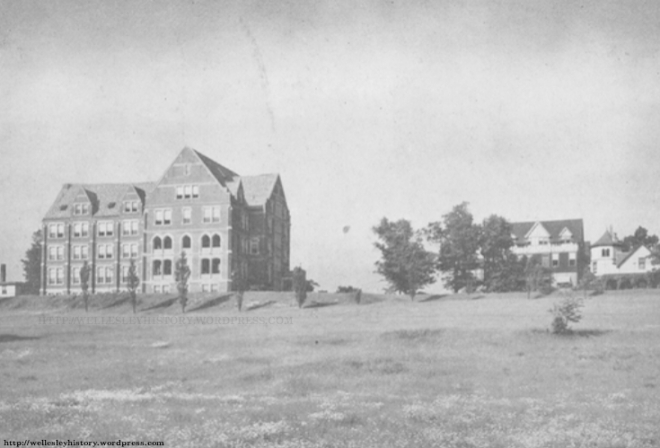
Main building and Bird-Scudder mansion (viewed from the eastern edge of the campus)
Source: 1931 Semi-Centennial Booklet
It appears likely that soon after this building opened in 1921, upon realizing the advantages of having an attractive campus that was visible from a major roadway, the Academy constructed the charming stone lodge that still stands at the intersection of Worcester and Oakland Streets. Beyond serving as a marketing ploy, this lodge provided shelter to students and staff who were waiting for trolleys on the Boston & Worcester Street Railway line.
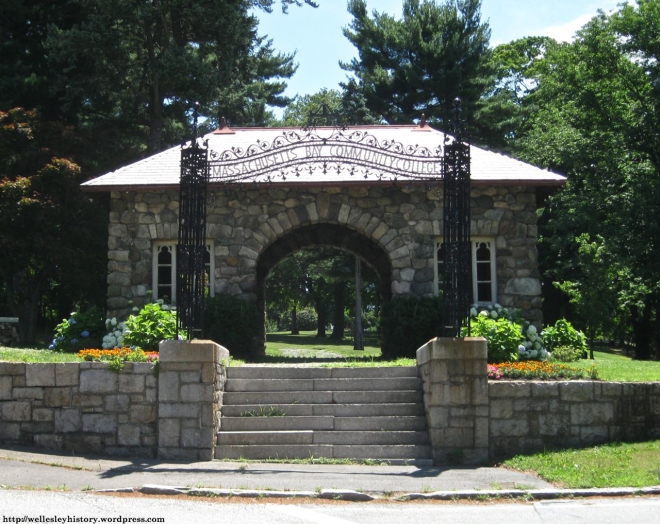
Stone Lodge at corner of Worcester and Oakland Streets
(Originally located at street level — moved when Worcester Street became a state highway in 1932-33)
Walk through that lodge and the following campus awaited you:
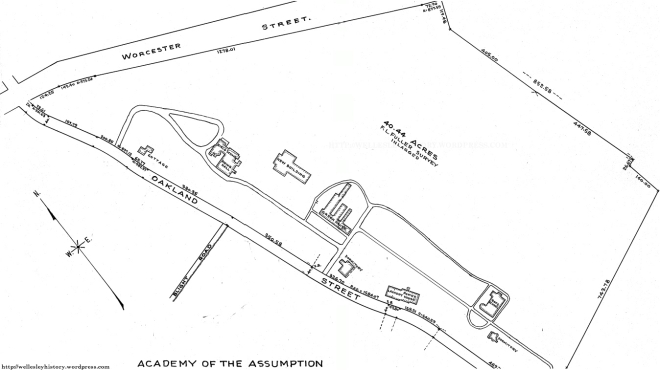
Map of campus in 1922 (prior to construction of stone lodge) — CLICK TO ENLARGE
Source: Norfolk County Registry of Deeds
As you can see, the only structures on the map that remain standing today are the ‘New Building’ and the ‘Laundry – Powerhouse’ building.
But there’s one other building from the Academy’s original campus that still stands and isn’t shown on this map: the Putney farmhouse. Located on the Academy’s 40-acre farm that it acquired the year after its purchase of the Bird-Scudder Estate (and included much of what is now the northeastern section of Wellesley Country Club’s golf course), this farmhouse served as the living quarters for the farmhands who grew the vegetables, milked the cows, fed the pigs, and collected the eggs that would end up on the plates of the hundreds of students and staff at the Academy.
So now that we’ve described the campus, what kinds of students went to the Academy of the Assumption and St. Joseph’s Academy?
From the beginning, both schools (obviously) catered towards Catholic children living within the region. Many were from Boston. And most were relatively poor children of immigrants primarily from Ireland, Italy, and Canada. The academies therefore offered not just a superior education but also a stable living situation for these children.
Not all students, however, fit that profile. Some of them came from more affluent Catholic families, most notably Dorothy Ruth, one of Babe Ruth’s adopted daughters who attended the Academy of the Assumption during the late 1920s when the Great Bambino was playing for the New York Yankees. (He even occasionally came to Wellesley to pick her up — an event that was understandably of great excitement to the townspeople.)
Nor were all students Catholic. In fact, many Protestant children from the surrounding area, including Wellesley, attended as day students.
As the years passed by, the Academy of the Assumption continued to grow, attracting more and more students from both Wellesley and far away places (including a whole bunch from Latin America). But in many ways, it was quite similar to most other religious schools in the region. The academy wasn’t even outrageously different from the other private schools in Wellesley.
There were two annual traditions, however, that helped the school stand out within the community: the Christmas Bazaar and Field Day.
The Christmas Bazaar was exactly what it sounds like: an all-day bazaar that was held a month or so before Christmas where patrons could buy handmade gifts, needlework, toys, and religious articles. And each year, it became a larger and larger event with the addition of movies, games, lots of food, and even an appearance by Santa Claus (who would fly in via helicopter instead of sleigh).
The other annual tradition — which was arguably even more exciting — was Field Day. First held in the 1910s, Field Day quickly evolved from what was more or less a pleasant social gathering into an all-out competitive sporting event where students from the Academy of the Assumption and St. Joseph’s would compete against students from other Catholic schools in various activities, including foot races, baseball games, horseback riding events, and even a military drill.
Its evolution would continue until Field Day had become a full-fledged carnival featuring rides, raffles, concerts, auctions, and all sorts of games. During the 1950s and 1960s, attendance each year reached upwards of five thousand.
Just as each Field Day was a resounding success, so was the Academy of the Assumption in general. Everything seemed to be looking great for the school. So much so that, once again, it needed more space and therefore constructed a large addition off the main building that included an auditorium, gymnasium, assembly hall, and more high school classrooms.
But this new space proved inadequate only one decade later, and so the Academy broke ground in 1963 for a relatively huge high school building (to be named after Elizabeth Seton) that would help give the Catholic Church a prosperous future.
There was just one huge problem: fewer and fewer religious sisters were available to teach at the Academy. The only solution therefore was to hire (more expensive and probably not as religious) lay teachers to fill open positions.
So, in 1966, the Church began construction on the new Mount St. Vincent Sister Formation Center. One could think of this facility as more or less a mini-college where up to 150 young women would study and train to become Sisters of Charity for the Boston and New York orders. In addition, there would be living quarters for a hundred current and retired sisters.
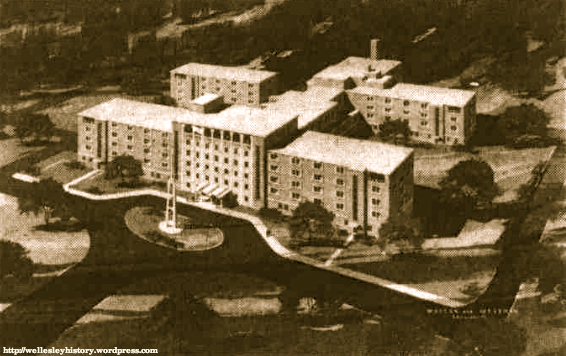
Sketch of Mount St. Vincent Sister Formation Center
Note that only front half of proposed building was constructed
(Posted with permission from the Wellesley Townsman)
At first, the new high school and Formation Center looked like they just might help the Catholic Church overcome its problems. Enrollment at the high school increased. And when the Formation Center opened in late 1967, there were 20 postulants (first year students) and 18 novices (second and third year students).
By 1971, however, the future looked less bright. Fundraising efforts to pay off the debts accrued during the construction of the Elizabeth Seton High School and the Formation Center had failed miserably. Furthermore, enrollment at the Academy was not high enough and the Formation Center was not bringing in as many teachers as the Church had hoped. Therefore, discussions to close the entire academy began.
Despite a frantic movement to save the school, it was announced in February 1971 that the academy would close after the 1971-72 school year. (By that point in time, the Formation Center had already been discontinued.)
Town officials immediately began salivating at the prospect of acquiring a vast amount of land in a nearly built up town. Proposals percolated. They could build a new high school there. Maybe construct municipal offices. Perhaps leave a large area as open space. But a vote to purchase the property for $6 million failed (82-118) at a Special Town Meeting in June 1971.
In swooped Mass Bay Community College (which was then located on the Watertown-Waltham line). Two months later, a deal was made between the Sisters of Charity and Mass Bay to sell the main part of the campus to the community college provided that the Commonwealth could allocate the money. (It did.) The 84-acre property was sold for $5,390,500 in October 1973. Despite strong objections by the townspeople, Mass Bay opened in the fall of 1974.
Of course, the Town didn’t come away empty-handed. As a consolation prize, it was able to snag 42 acres of the former Academy farm (for only $1.1 million!) in 1980 for Centennial Park, the Town’s present to itself for the approaching 100th anniversary of its separation from Needham.
Today, the only physical reminders that the Academy of the Assumption was a significant part of Wellesley for nearly eighty years are a few campus buildings and structures as well as the Elizabeth Seton Residence.
Looking back on the last few decades of the Academy’s existence, was there anything the Sisters of Charity could have done differently to prevent the outcome that occurred? I’m not really sure.
On one hand, there are plenty of Catholic secondary schools still open in Massachusetts. Why not the Academy of the Assumption as well?
The facts, on the other hand, tell a different story. Between 1965 and 2014, the number of religious sisters nationwide has dropped by 72%, the number of priests by 35%, and the number of Catholic secondary schools by 22%. We’ve even seen the declining influence of the Catholic Church elsewhere in Wellesley, with the closure of St. James the Great in 2004.
I therefore suspect that the only way the Academy of the Assumption could have survived was if the Church had not acted so foolishly with its own money in constructing the Formation Center. Yes, the Academy would have had to rely on the Catholic laity to teach. But don’t you think that’s a much better scenario than what actually happened?
Note: All color photographs were taken by Joshua Dorin in July 2014.
Sources:
- Federal Census Reports of 1860, 1870, 1900
- Boston Daily Globe: 31 August 1875; 19 June 1892; 12 September 1893; 29 October 1967
- Life of Mrs. Eliza A. Seton, Foundress and First Superior of the Sisters or Daughters of Charity in the United States of America by Charles I. White (1880)
- A Directory of the Charitable and Beneficent Organizations of Boston by The Associated Charities (1891)
- The Sacred Heart Review: 15 September 1894; 7 August 1897; 27 August 1898
- One Hundred Years of Progress; A Graphic, Historical and Pictorial Account of the Catholic Church of New England; Archdiocese of Boston by James S. Sullivan (1895)
- Atlas of the Town of Wellesley, Massachusetts by Geo. W. Stadley & Co. (1897)
- The Catholic Directory, Almanac and Clergy List by M.H. Wiltzlus Company (1901)
- Wellesley Townsman: 29 May 1908; 28 November 1919; 16 June 1922; 14 July 1922; 4 May 1923; 22 June 1923; 12 June 1925; 18 January 1929; 23 March 1933; 1 June 1934; 29 November 1935; 3 June 1938; 24 May 1940; 18 November 1943; 18 September 1947; 30 September 1948; 21 September 1950; 24 May 1951; 29 November 1951; 14 February 1952; 22 May 1952; 19 March 1953; 23 September 1954; 12 May 1955; 23 June 1955; 24 May 1956; 20 September 1956; 8 November 1956; 25 May 1961; 16 November 1961; 23 May 1963; 31 October 1963; 12 December 1963; 17 September 1964; 2 September 1965; 19 May 1966; 23 June 1966; 26 October 1967; 14 January 1971; 28 January 1971; 25 February 1971; 24 June 1971; 12 August 1971; 26 August 1971; 8 June 1972; 11 October 1973; 5 September 1974; 15 May 1980
- The Book of Boston by Edwin Monroe Bacon (1916)
- The Reading Eagle: 17 January 1929
- 1931 Booklet for the Semi-Centennial of the Town of Wellesley
- Guide to the Religious Life: Archdiocese of Boston by Albert R. Mann (1945)
- The Sisters of Charity of New York, 1809-1959 by Marie de Lourdes Walsh (1960)
- Charity Alive: Sisters of Charity of Saint Vincent de Paul, Halifax, 1950-1980 by Mary Olga McKenna (1998)
- Center for Applied Research in the Apostolate — Frequently Requested Church Statistics — accessed in August 2014
- Norfolk County Registry of Deeds
Bonus Photo: Anyone know the origins of this cornerstone? I suspect it came from the main building of St. Joseph’s Academy, which was razed between 1969 and 1971, but I’m not 100% sure.

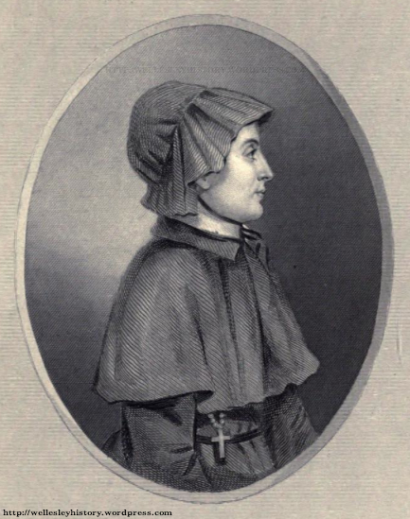
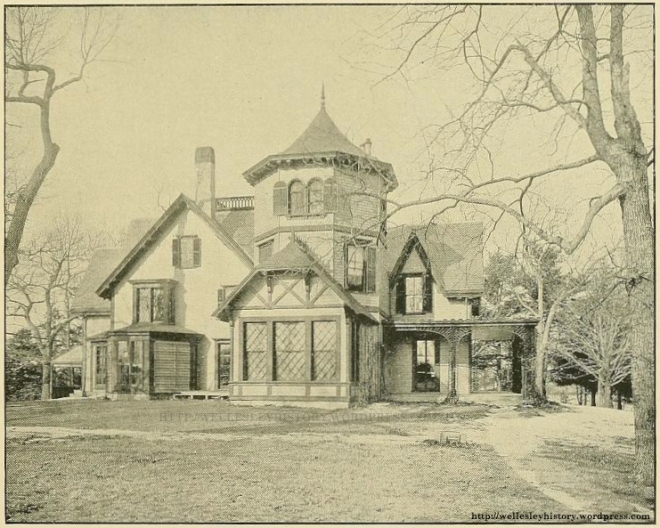
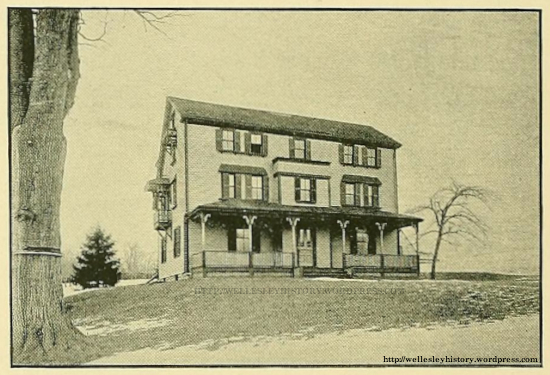
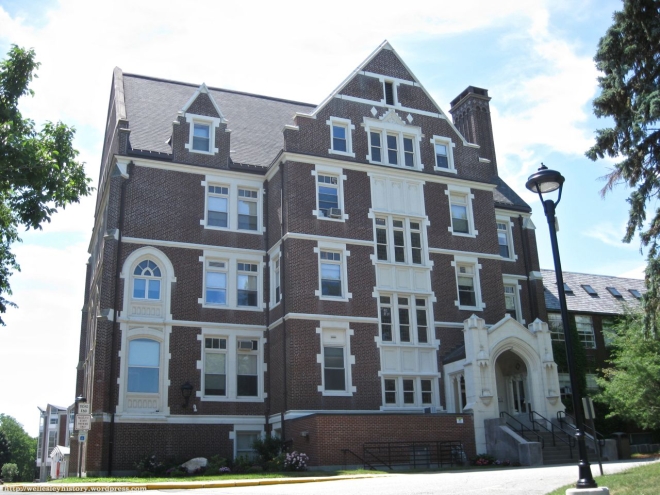
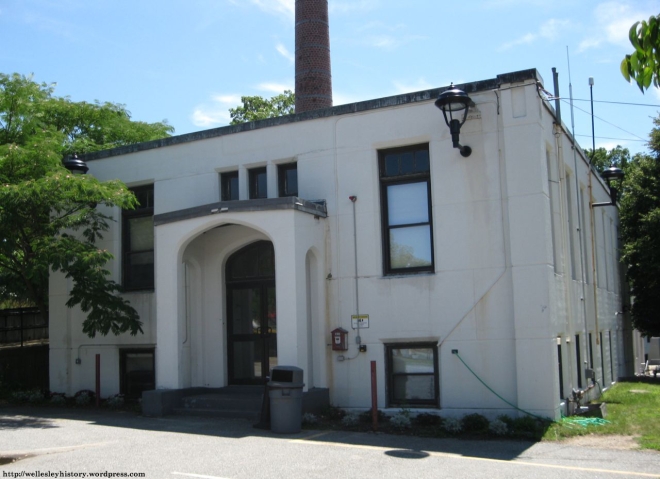
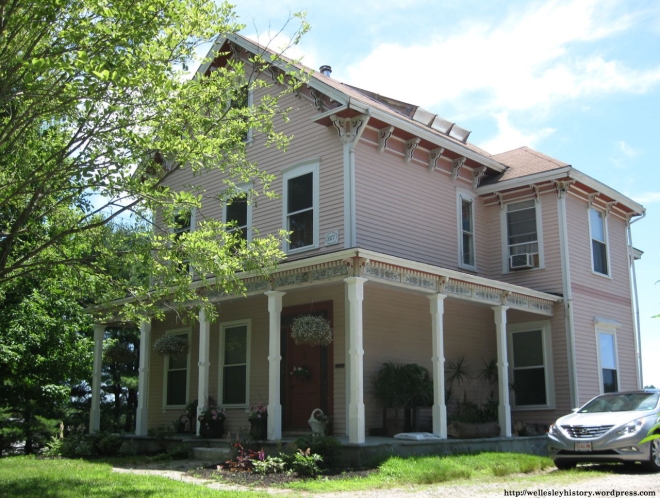
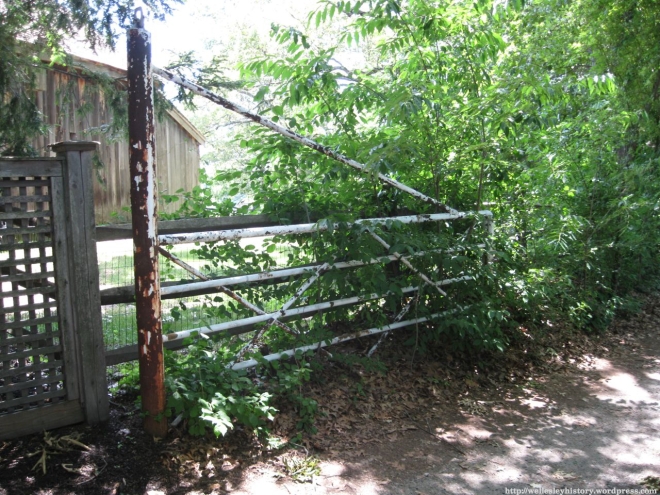
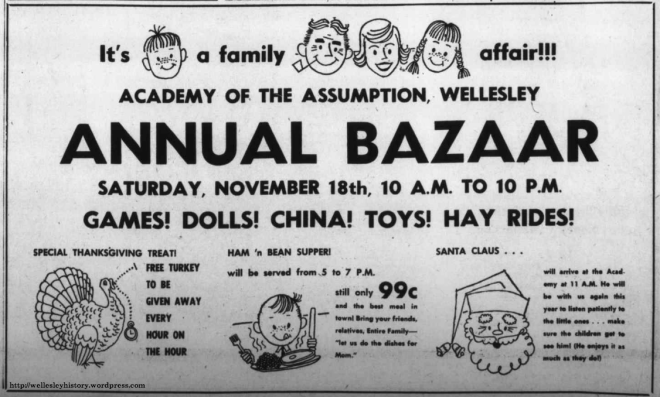
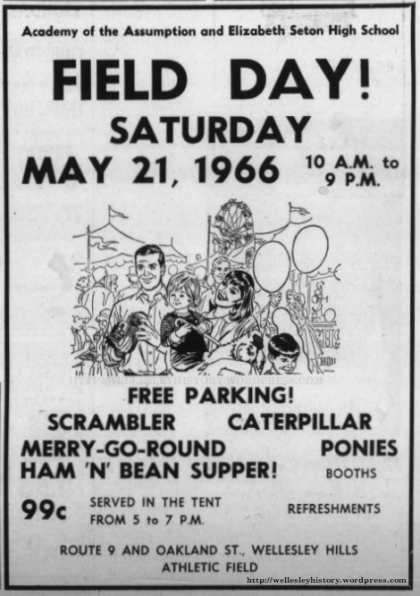
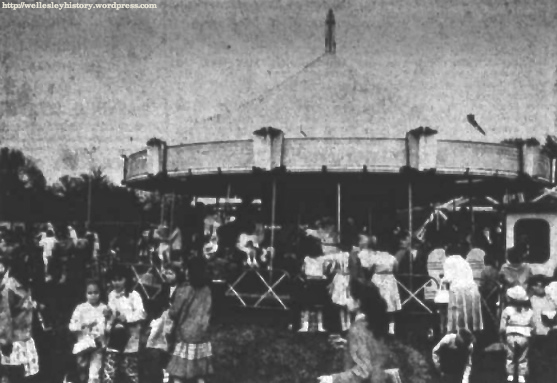
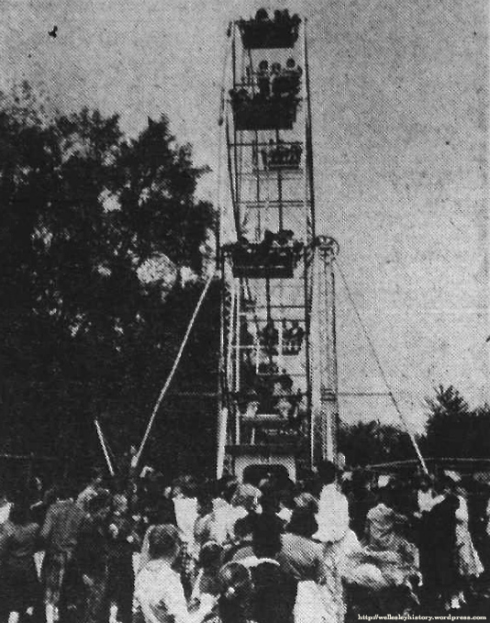
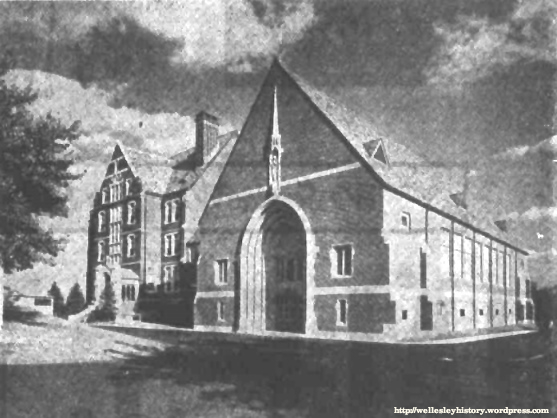
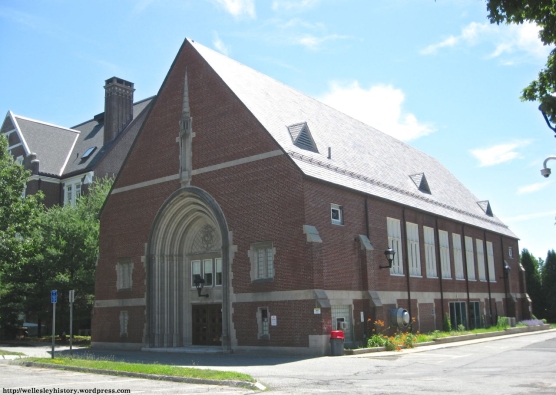
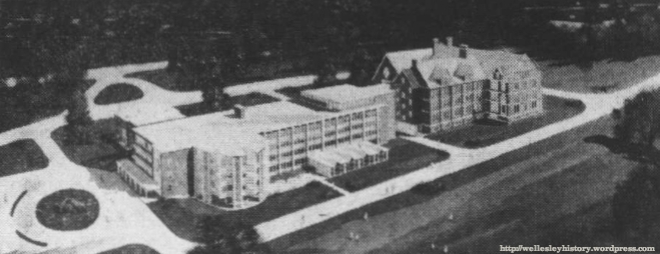
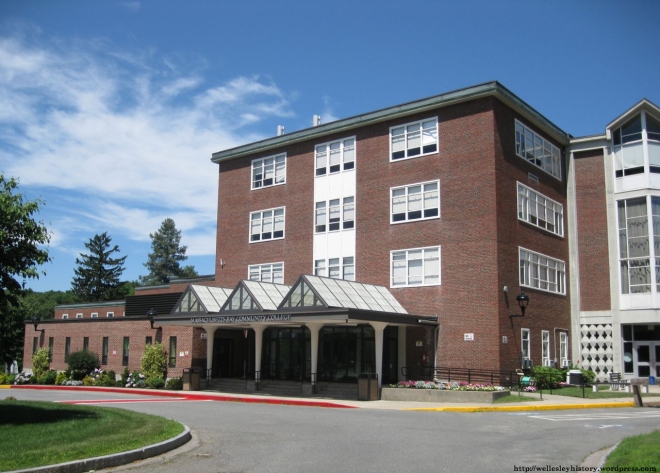
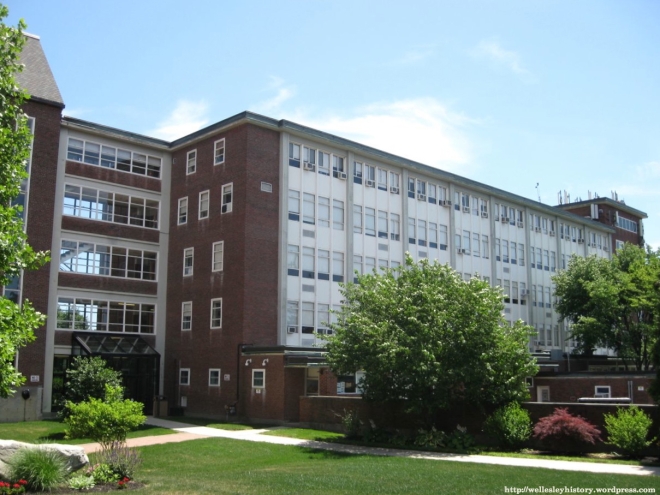
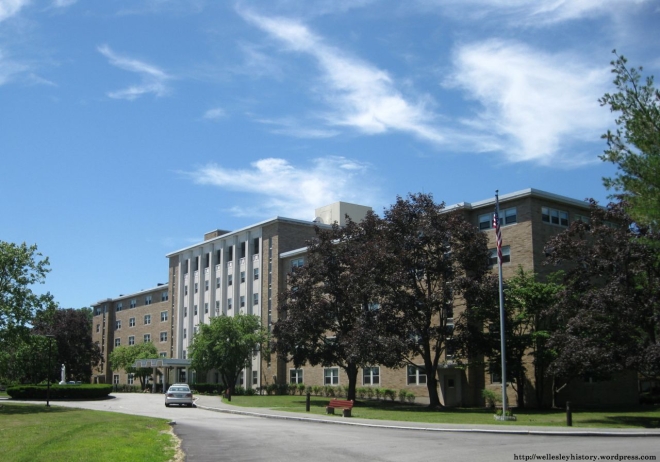
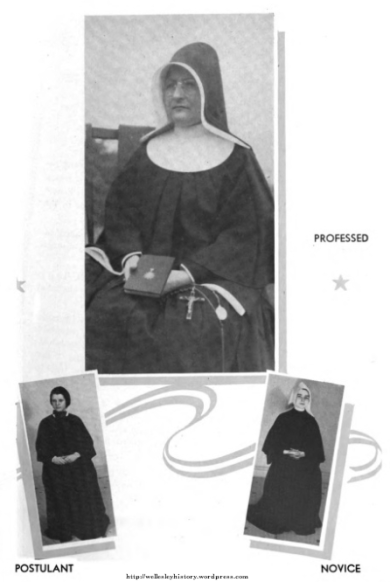
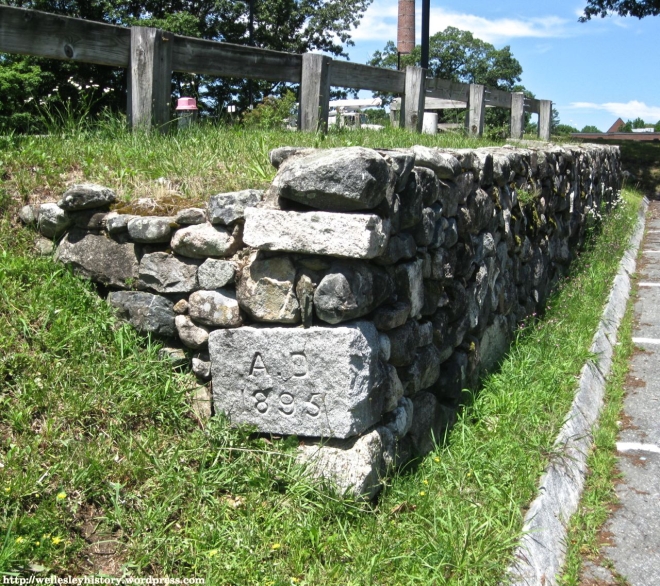
Josh Thank you for this post. AoA was an important part of my three older sisters growing up. Each year we went as a family to field day and to the Christmas bazaar with the hay ride. Also the sisters of charity taught at saint Paul school which rest of my siblings went to (six of us). Keep it up I thoroughly enjoy all your stories of Wellesley. Gretchen Fulham
Moved to Lincoln Road in 1965 when the AoA had a herd of Black Angus cows on the farm. This is prior to the Wellesley Country club acquiring much of the pasture land for the golf course re design. As a recent transplant from New York City we thought we were way out in the country. As always a great post.
Thank you Josh! What a gold mine of information. The AoA was my first school. I attended 1st & 2nd grade with my sister (a year ahead of me), during the mid-50s. Your photos bring back so many memories. I remember well the little boys’ school (St. Joseph’s) over at the other end of the drive, just above the “Field Day” field. And the cottage below where some of the elderly sisters lived (this cottage, as well as the classrooms, study halls and dormitory are featured in occasional dreams).
We often boarded when my father was away on trips and couldn’t drive us in from where we lived in Hopkinton at the time. So we had the benefit of wonderful meals in the refectory. Stacks of breakfast toast quite soaked in fresh butter and enormous bowls mounded high with vanilla ice cream, all of it produced at the farm.
The dormitory was a forbidding affair; somewhere in the upper reaches of that tall main building was a long, windowless room, with tongue-in-groove wooden walls, divided into what they called “alcoves” by wooden dividers on both sides of a central corridor, each with a curtain, a nightstand, a bedstead and a hook on the wall for our uniform, and perhaps a small chair, but I’m not sure about the chair. It was a rather stark environment for a 5-year old. I’m sure the young postulants & novices slept in a similar arrangement. There were girls recently come over from Cuba, because of the trouble with Batista. They were frightened and lonely and often cried at night. The sisters were not good substitute mothers, with one exception: Sister Hubert, God bless her! Girls in Grade 5 and above were designated as “Agnetians” and assigned to look after the younger ones. Thanks to the patient care of my Agnetian, I learned to tie my shoes; we wore brown lace-up oxfords with our navy blue jumpers. I think the Agnetians’ uniforms changed to a skirt & blouse with a sweater, but always, the knee-socks.
Outside the dormitory down the hall a ways was the lavatory, another long room with two rows of porcelain sinks all plumbed together, running down the middle. We kept our toothbrushes in cubicles and did all our washing up in this scary place.
Wending its way up the hill from the Stone Lodge was a pathway with Stations of the Cross. I’m sure they were removed when the property was converted for secular use. My sister Martha and I made our First Communions in the chapel. First Communion was followed by a gala luncheon in the refectory with lots of that famous ice cream. I’m sure we have snapshots of that somewhere.
Our family moved to Wellesley in 1961 and we attended St. Paul School, so at least the nuns were familiar (their habits, anyway).
I am so grateful for this post. It’s helped to bring back a lost chunk of childhood.
I’m just adding to my sister Agnes’s about our shared experience of the Academy of the Assumption. As Agnes said, we both went to school there in the mid to late 1950s. I started in September 1956, a year ahead of Agnes. Everything she has described about the dormitory on the 3rd floor and the dining room on the 1st floor is correct. I’d like to describe the second and first floors of the Scudder building where grades 1-4 and the Junior girl’s dormitory were located. The second floor had classrooms for grades 1-4. Three of them, (1st-3rd grades) looked out over Rte. 9. They were well lit by tall windows facing east towards Rte 9. Sometimes I could see the tower of Boston College’s main building from these windows. This was a source of great pride because our father taught at BC. The classrooms all had statues of Our Lady and of the Infant of Prague as well as the requisite crucifix. The letters of the alphabet in print (1st grade) and cursive (2nd, 3rd, 4th grades) were posted above the blackboards. The second floor also had a wood-panelled library/study where we went for recreation on rainy days and went to write letters home on Sundays whenever we were boarding at school. This room also had a collection of books that we could read during recess or after school. This collection included the Nancy Drew and Bobbsey Twins series. There was also a TV where we would watch a program about books such as “Make Way for Ducklings” on the NET channel (Channel 2). A rather dark and winding stairs took us down to the first flooor where we ate, went to chapel, and hung our coats in the locker room.
Meals were served in the refectory on the first floor, breakfast, lunch, dinner for boarders and lunch for day students. We sat at table and were watched over by older students called Agnetians and served by ladies who worked for the school. Agnes has described the delicious food…especially the ice cream which was mounded like a great white mountain onto a serving platter. We were required to bring a napkin ring from home with our name tag attached to it. We received cloth napkins that we learned to fold and roll up after each meal.
The chapel, where we made First Confession and First Communion, was also on the first floor. Between the chapel and the refectory was a rather formal parlor that led onto the tunnel that connected our classroom building with the brick building. We used this tunnel to go to the brick building for gym class in the gym or events in the auditorium, usually a movie.
When we boarded, we would go for walks on the weekend. Sometimes we would walk to the farm; other times we walked into Wellelsely Hills where we could get ice cream at Brighams. We were always supervised by one of the sisters and walked in an orderly fashion. I always felt like Madeline and the “twelve little girls in two straight lines” walking with Miss Clavell.
I the winter, we went sledding on the hills overlooking Rte. 9. We were not allowed to lie down on our sleds (Felxible Flyers) but had to go down sitting up. The sisters considerd it to be unladylike to lie down on the sleds.
Agnes is correct in remembering the Cuban and South American students. There was a Cuban girl in my class; also a Hungarian girl, whose family was fleeing Hungary after the Hungarian uprising was put down. These girls were often comforted, as we all were, by the wonderfully kind Sister Hubert.
Many thanks for all the information about my first school.
Oh, my goodness, your post brings back such memories of the four years I boarded at A.O.A. I loved Sr. Hubert! One lasting memory to add was the tunnel between the old dormitory building and the chapel.
oh yes I remember that tunnel well
Mary Ann Alderman Class of 1962
I went to school in the late 50’s and early 60,s I remember sr. Hubert very well she use to give us bedtime snacks apples and bananas cut up.
Do you remember the paper machet Halloween decorations? Or learning how to sew?
I boarded those same years wonder if I knew you Barbara Cray
I remember you, you were a grade above me and a year behind my sister Mary if I remember correctly
Very impressive. I like your writing style, particularly.
Josh, just read the Central Street piece. Such a rich history on such a short road. Wish that Crocker’s tavern still existed, but glad the stables are gone, especially at the bottom of Crest because aromas waft upwards. Looking forward to your recent history. When do you do the lectures?
Sent from my iPad
>
Interesting article. My mother worked at the academy around 1940. She along with many other orphans went to work there when they were too old for foster care. She had many friends who were in similar circumstances. The nuns were very good to these young men and women. I still have gifts she received as wedding gifts. One she spoke of a lot was Sister Marguerite. Thank you.
I was a student at St. Joseph’s from 1945 through 1951.
After leaving, I missed it greatly. Marching, Field Day, May Day celebrations, and some very good teaching.
Along the way, Sister Regina Agnes raped my knuckles very harshly for errors on the piano, and my sixth grade teacher sat Robert Di Napoli on a dunce stool .And she did indeed place the pointed hat on his head. Learning disorders were regarded as discipline problems, not a useful formulation.
A former classmate, Salvatore DiFazio, now Tory, was a good friend as was the undertaker’s son, George (Digger) Dougherty.
I made my First Confession in the chapel but disobeyed my mother before receiving Communion. She made me confess again, which was most embarrassing. Summoned for just this one Sacrament repeat, the priest was visibly pissed when he heard its cause. One Hail Mary,a Glory Be and I was on my way
I saw a dead person for the first time, Sr. Maria Bernard, during her wake in the chapel. I have never forgotten that during my long career in medicine when so many others joined her.
On a lighter note,my teacher was scandalized by the story written and read in class by Jay Karl. A picaresque tale of ethnic stereotypes, Luigi and Pasquale, laced by Keystone Cops antics and the reek of beer and wine, she finally succumbed to its infectious humorous.
Michael, I was enrolled at the Academy in 1946 in kindergarden in the Elms. Moved up the hill a year or so later, left for economic reasons in the second grade and re-entered the end of fourth grade through fifth – 1953. I recall a Sister Hubert who talked to me frequently, because my sister Rosemarie Dini had attended the Academy in the early 1930s with my brother William who started in the 1920s. I recall being treated warmly, especially by Sister Mary Francis of Rome. Field day was a blast. This was a great read to pass on to my grandson. Thanks, Joseph Dini
Reblogged this on A Route Obscure and Lonely….
Thank you for such a great blog! My dad and two of his sisters attended the Academy and St. Joseph’s in the early-mid 1940s and it was wonderful to have your understanding of the history of life for these children.
Thank you Josh for bringing back some wonderful memories of AOA. I was a day student there from the late forties to mid fifties. A good friend lived near the sisters’ farm, and every so often one of them would call her out of class to tell her to keep her dog tied up at home. When he got free he used to chase the cows and cause hysteria in the herd! There were many times I boarded on a temporary basis. In the early winter it was a beautiful sight to sit in study hall and see the lights from the traffic on Rt 9. Also all students had to have an apron for meals…..many pieces of liver and fried baloney ended up in the pocket of that apron!
In the early years we would leave coats, etc in lockers. I remember the girls from the upper grades removing their blue and white saddle shoes from their lockers and adding a coat of shoe polish to the white leather. Heaven forbid they wear those shoes any other place and get them dirty.
So many more memories make me smile. Thanks Josh for the history and anecdotes of The Academy.
I was part of the last graduating class from Elizabeth Seton (main building) in 1972. We lived in Needham, and I transferred to Seton for high school in 9th grade. What a wonderful, rich community it was. Nice girls and great teachers. (well, mostly! Like all girls, we had our favorites and our not-so-favorites!) I spent a lot of time in the art studio on the third floor of the (newest) classroom building, where there was a fantastic view over the trees toward Boston. Especially in the fall, it was breath-taking.
Even when we were there, most of the teachers were sisters. I only had a few lay teachers, our gym teacher, (which makes sense… running around in a habit wouldn’t work too well!) our Spanish and German (also Russian) teacher and our art teacher. It seems to me, that even in the heyday of religious instructors, it would be hard to find nuns who had the background to teach these specialized subjects.
Our graduating class was just under 75 girls, and I think it was very special to all of us, knowing we were the last. (although I know one more, even smaller, class moved across the street and graduated from Mount St. Vincent) I am very glad that the buildings are still used for education, but it hurts my heart a bit to walk into “our” chapel, and see it being used as a computer lab. At least the left the beautiful stained glass windows intact!
I loved this post. I went for first grade only to AoA. Taught by Sister Claire Theresa 1966-1967. I had some lovely memories of that sunny, many-windowed room where we stood up when anyone came in the door, or when we answered Sister. I remember reading circle, getting in line to walk down the hall to lunch or recess, I remember the “candy cupboard”, and singing in the lunch room to such songs as “At Three O’Clock in the Morning.” Years later for an assignment in an MFA Nonfiction program at the New School in NYC I interviewed Sister Claire Theresa by phone. Why did I think she’d remember me? Anyway I got an interesting story of her training for the sisterhood in Halifax, Nova Scotia in the 1940s. If she’s still alive she’s in her late 80s. I’d love to hear from anyone who was in my class! Names i remember: Nancy and Susan McGinnis, Kathy Hallinan, Patrick Kelly…what wonderful memories I still have.
I was a student at AOA from first grade through high school graduation in 1963. My great aunts were in the Sisters of Charity, one was my first and second year teacher, Sister Enestine. My other great aunt, Sister Mary Clarissa, was provincial for New York, New Jersey and Bermuda. Three more of my sisters attended the school as well, as well as my only brother. In 1963 I entered the order myself, traveling to Halifax. There were 60 young women who entered with me that year.I was professed in 1967! and as you noted in your well written article, those years were to be turbulent ones for the Catholic Church. I left the order in 1967. Last month I reunited in Halifax with the last eight sisters still in the order…this was a chance to celebrate their golden jubilee! I just say that I owe a lot to the sisters who provided me with such a rich and wonderful education. Reading other comments here has reminded me of so very many memories, and so I thank you for taking the time to provide such a detailed historical look back in time.
Do you have a sister Maura? I remember a
Girl by that name in my time there
My sister Moira, six years younger than me, did go to AOA too. My other sisters : Loretta and Stella were there as well. Lesley
I am pretty sure Maura was a contemporary.
There were four of us Richardson girls there at the same time. Joan, the oldest would have graduated in 1964, Louise 1965, Mary 1968 and I would have been 1970. We left at the end of the 1962 school year. I completed 4 years and boarded the whole time.
Leslie, I remember you were an Agnetian when knew Moira and Stella. Maybe you were even the one who helped me learn to tie my shoes. I think I also remember Eugene. We’re all getting old now, but these memories are a treasure.
The memory are still their, col. Driscoll. our drill teacher,the walk from where we slept and went to class to the main bldg to eat our meals ,and mass ,to coasting in the winter on the hill behind our house to the great field day each year..was a great time in those days .have lots of pictures to remind me of the good times. I am 82 now
Great time back in the forty,s
I attended this school along with my brother james
From 1st to 8th grade – in the 60s. It was called Academy of the Assumption . We wore crested blazers with that crest It was boys and girls till 8 grade then
All girl high school . Our 7th and 8 th grade moved from that horrid wooden building to the newer build. To the north on rte9. Worst experience of my life
Nuns hid abuse behind cross and students were singled out especially the ones abused by priests .
Sister mary luke was the nastiest principal imaginable
Beat students , hid abuse . The rose colored description is a complete joke .
I suspect that my father and possibly my uncle too went to the AOA in the 1920’s when they were young (approximately 10). I also suspect that they were abused by the nuns (as per comments from my mother) (and possibly by the priests as well!!) and that resulted in my father’s complete rejection of the Catholic Church for the remainder of his life. My father died in 1964 when he was only 53. If I wanted to investigate it further, how would I find out if he attended the school in the 1920’s? Are there historical records out there?
CHG
Thank you for this rich article. I attended Elizabeth Seton and graduated in 1970. I commuted from Jamaica Plain. After being accepted I decided to choose Seton because Elizabeth Seton was a modern day saint. The campus of Seton was beautiful too. The school had a beautiful new foyer, new library, new auditorium, and new classrooms. Combined with the architecture of the old school, I was sold. I received a solid pre- college education and met wonderful life long friends. Girls from South America lived at Seton and attended classes with us. I enjoyed meeting these girls and it gave me an education as well. The sisters tried to give us many finishing touches. We were offered classes in Chorale, Business, Sewing, and Art. We had a wonderful gym program and we were able to play competitive basketball. We were offered classes in horseback riding. We attended professional Shakespeare plays at Framingham High school. We traveled to New Your City to see “Hello Dolly” with Pearl Baily. We held an educational day where we researched the Vietnam War instead of going into Boston to protest.
The 60’s and 70’s were tumultuous years. Everything was being questioned and this resulted in much change. I believe life is like this and history shows it. I am very grateful for my opportunities in life. Someone recently said change is inevitable and we must adapt and be resilient. My small catholic college also closed and I was still attending the school. These changes in the catholic process helped form my character and the person I am today. I am stronger because I faced it. My catholic faith is strong today because I was tested. God bless everyone who passed my way at Seton and who continue to meet me today. God bless us all during this pandemic and may God keep you in the palm of his hand.
Hello to all, I just thought to inform those Elizabeth Seton girls who may remember my aunt, Sr. Edward Therese, who taught there in the late sixties, passed away last fall. She spent her career doing outreach and pastoral counseling in Quincy, before retiring to Mt. St. Vincent. She had a long and fulfilling life and lived just shy of her 96th birthday. Here is a picture of her in her habit.
Sent from my iPad
>
Thank You to the Elizabeth Seton girls who posted their wonderful memories. I often refer to the four years at Elizabeth Seton H.S. as among the best in my life. The education we received was second to none as it prepared us for a successful college experience. I was one of the 52 girls who had the great fortune to graduate in 1973 after attending our last year at Mount St Vincent across the street. Many articles have been written that don’t recognize the class of 1973 which is unfortunate since it was an amazing class. Together we rose to the challenge of moving to a very different environment and with the dedication and support of the Sisters and staff, we graduated with friendships and memories that will last forever. Elizabeth Seton High School was a blessing in my life and for that I will always be grateful. May God bless all Setonites and the Sisters, staff and parents that made it all possible.